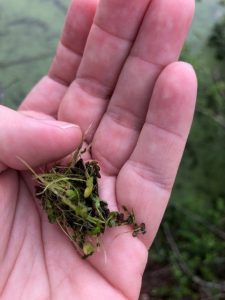
At first glance, I thought I was looking at a pond completely overtaken with green algae. You see rivers and lakes like this, especially in South Florida where development is denser and the phosphorus levels are naturally higher. But I was a bit surprised to see a water body so truly bright green in our area. On further investigation, I found that it was actually covered with a very small aquatic plant called Duckweed (Lemna spp). Smaller than a pinky fingernail and similar in leaf shape to a clover, duckweed is the smallest flowering plant known to botany. In fact, the flowers are microscopic and rarely noticed.

Duckweed floats at the water’s surface, and spreads rapidly by asexual reproduction via buds on their stems. Their fibrous roots float as well, taking up nutrients directly from the water. The plant thrives in the protected, still water of ponds, lakes, and lagoons. Fish and aquatic birds eat duckweed, making it an important food source for native animal species. When unchecked by humans or wildlife, though, the fast-growing plant (it can double its mass in less than two days) can take over an entire pond.
Like any plant, duckweed thrives on additional nutrients. There is likely a source of too much fertilizer nearby, with the probable culprit being an adjacent golf course. If property owners find a pond fully overwhelmed with duckweed unsightly, the plant can easily be raked or seined up, opening the surface water for ease of navigation and improved aesthetics.

However, a body of water covered in duckweed is not as problematic an issue as an algae bloom. In fact, duckweed has been intentionally planted in many high-nutrient environments as a bioremediating factor, processing excess nitrogen and phosphorus and pulling them out of the ecosystem like a natural wastewater treatment plant. In some areas, duckweed is harvested as a crop, and used as a nutrient-rich feed for livestock. Because of its rapid rate of reproduction, the plant is also being used in biomedical research, synthesizing insulin and other proteins used in healthcare.
 0
0
